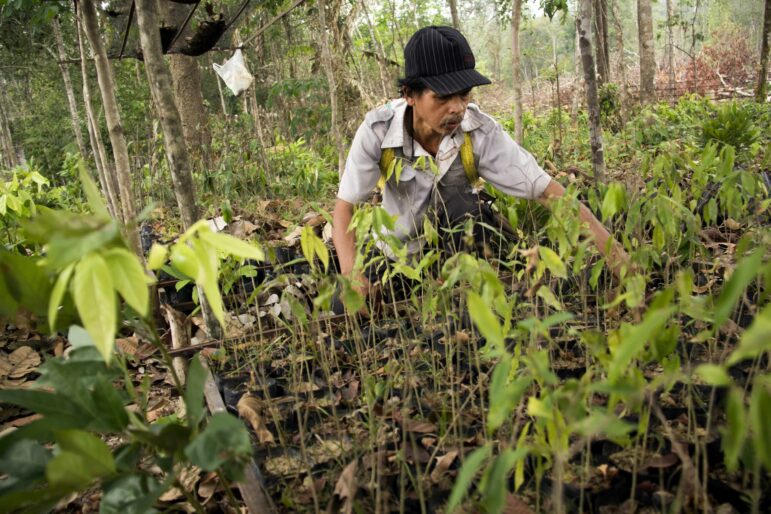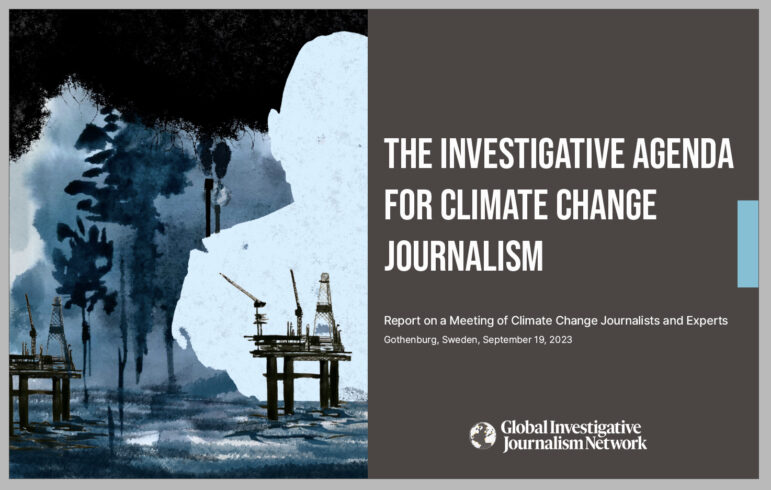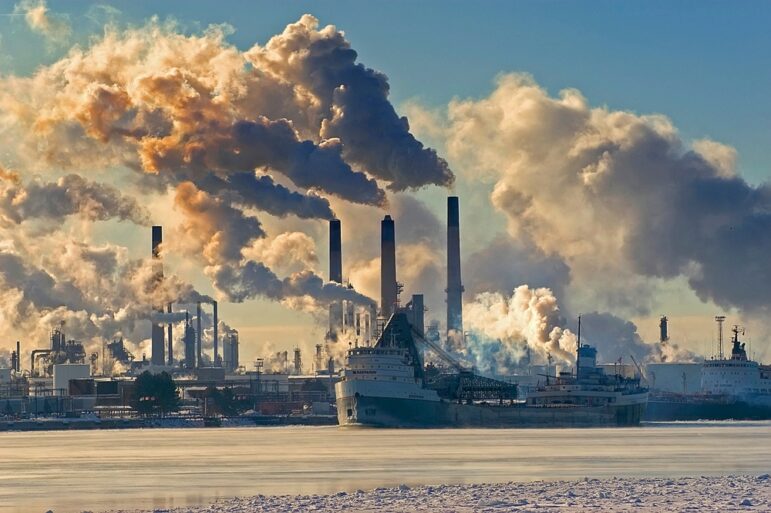

A collaborative investigation into financial greenwashing found that nearly US$300 million in sustainability-linked loans went to companies in polluting industries such as fossil fuels and mining between 2018 and 2023. Image: Ivan Marc, Shutterstock
How We Revealed Mega-Polluters Taking Advantage of Green Loans
In recent years, banks and corporations have poured trillions of dollars into finance they label as “green” or “sustainable.” Their claims about what this money will achieve sound impressive, but in many cases they amount to empty promises.
For this investigation, we examined a type of green finance called sustainability-linked loans (SLLs). SLLs tend to be massive — think billions of dollars — and they offer companies reduced interest rates if they promise to achieve environmental goals, like cutting carbon emissions or cleaning up supply chains. But unlike other kinds of green finance, the money from the loans doesn’t have to be used for green purposes, and neither the companies nor the banks have to disclose their environmental progress or even their benchmarks for success.
Our investigation found that nearly US$300 million in sustainability-linked loans — almost one out of five dollars in total SLLs — went to companies in polluting industries such as fossil fuels and mining between 2018 and 2023. In some cases, companies’ carbon emissions increased even as they benefited from SLLs linked to decarbonization. The project was published by The Examination, Associated Press, Toronto Star, and Mississippi Today, and the reporting was supported by the Pulitzer Center’s Rainforest Investigations Network.
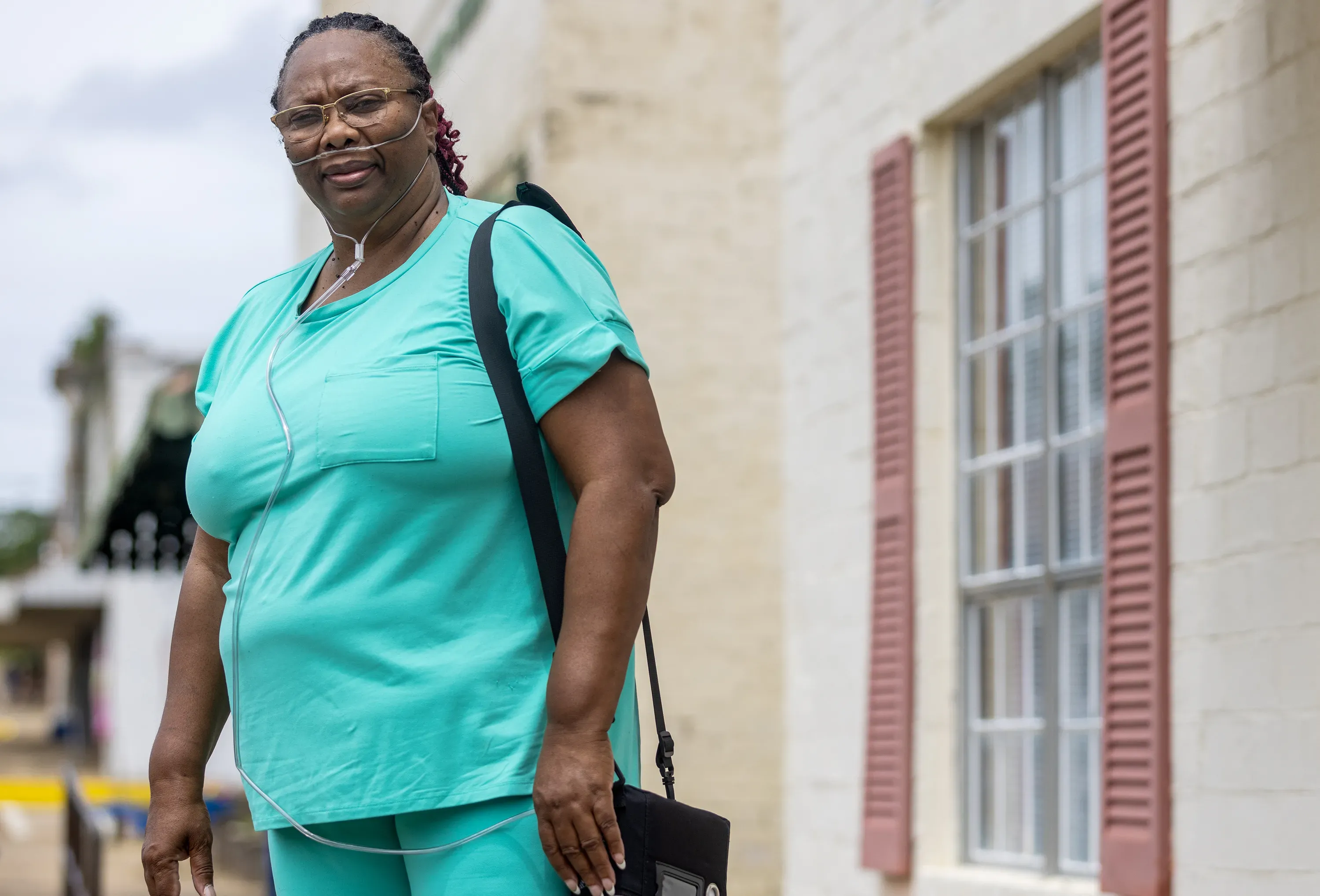
Virginia Weary, 60, had to quit her job because of severe respiratory ailments. She suspects that emissions from Drax’s Amite wood pellet plant in Gloster, Mississippi, contributed to her illness. Image: Courtesy of Eric Shelton, Mississippi Today.
Hypothesis
We wondered if SLLs were being abused for greenwashing. We wanted to analyze the data and see if we could shed light on how these loans are used, and whether companies were taking better care of the environment after receiving these loans.
Data Sources
- London Stock Exchange Group (LSEG): A financial data firm with proprietary data on sustainability-linked loans worldwide, covering details such as the recipient, issue date, and value of these transactions.
- Environmental Paper Network biomass data: A global dataset of companies and facilities with wood biomass operations, compiled by a network of civil society organizations.
- Forest 500 Company Rankings: An index of the most influential companies linked to tropical deforestation, created by the environmental transparency group Global Canopy.
- Corporate documents: Company annual reports and sustainability reports, collected from company websites.
- Standard Industrial Classification (SIC) Manual: A taxonomy of major industry groups by the US Occupational Safety and Health Administration (OSHA).
Investigation Methodology
1. Finding a Global Dataset
We wanted to get a full global picture of the market for sustainability-linked loans. Our challenge was that none of this data is public. Limited data on SLLs are available in private financial datasets like LSEG and Bloomberg, but those require expensive subscriptions.
We tried emailing LSEG to see if they would share it with us, but they wouldn’t provide more than a summary. We were able to get access by reaching out to Data Desk, a consultancy that works with journalists and other investigators of environmental finance. Data Desk has a subscription to LSEG, and we hired them to access data on SLLs from LSEG’s Deal Screener App and conduct topline analysis — a service that costs a fraction of getting an LSEG subscription.
Later in the project, we worked with the Toronto Star, which had access to a Bloomberg terminal that allowed us to confirm and dig deeper on several data points.
2. Analyzing the Data
One of the biggest challenges in this project was analyzing our SLL data, which came in an Excel spreadsheet listing more than 4,500 SLL payments totaling more than US$1.5 trillion. It wasn’t feasible to assess the environmental impact of each company, so we focused instead on identifying loans that went to companies in polluting industries. Prior research had examined how sustainable debt supports fossil fuels, but our analysis also brought in other key industries that are directly contributing to global warming, primarily through deforestation.
We decided on five sectors that would be at the heart of our analysis:
- Fossil fuels
- Mining
- Food and agriculture
- Timber
- Companies included in the Forest 500, an index of companies linked to tropical deforestation
To classify companies within these industry groups, we used subcategories from the “Major Industry Group Description” variable for each company contained in the LSEG data. We then matched these subcategories with a taxonomy from the OSHA. We included subcategories whose activities directly contribute to the main climate consequences of these broader industries, as well as subcategories that are direct buyers of climate-risk products. Industry subcategories with indirect impact on the climate were excluded. (For example, dairy farms and beef cattle feedlot companies were included, but refrigerator manufacturers that help maintain these products were not.)
Some companies were included in more than one of these categories, but duplicates were removed in calculating the total value of SLLs obtained by these industries collectively. The findings do not suggest that each individual company contributes to climate change, but they all sit within an industry that does.
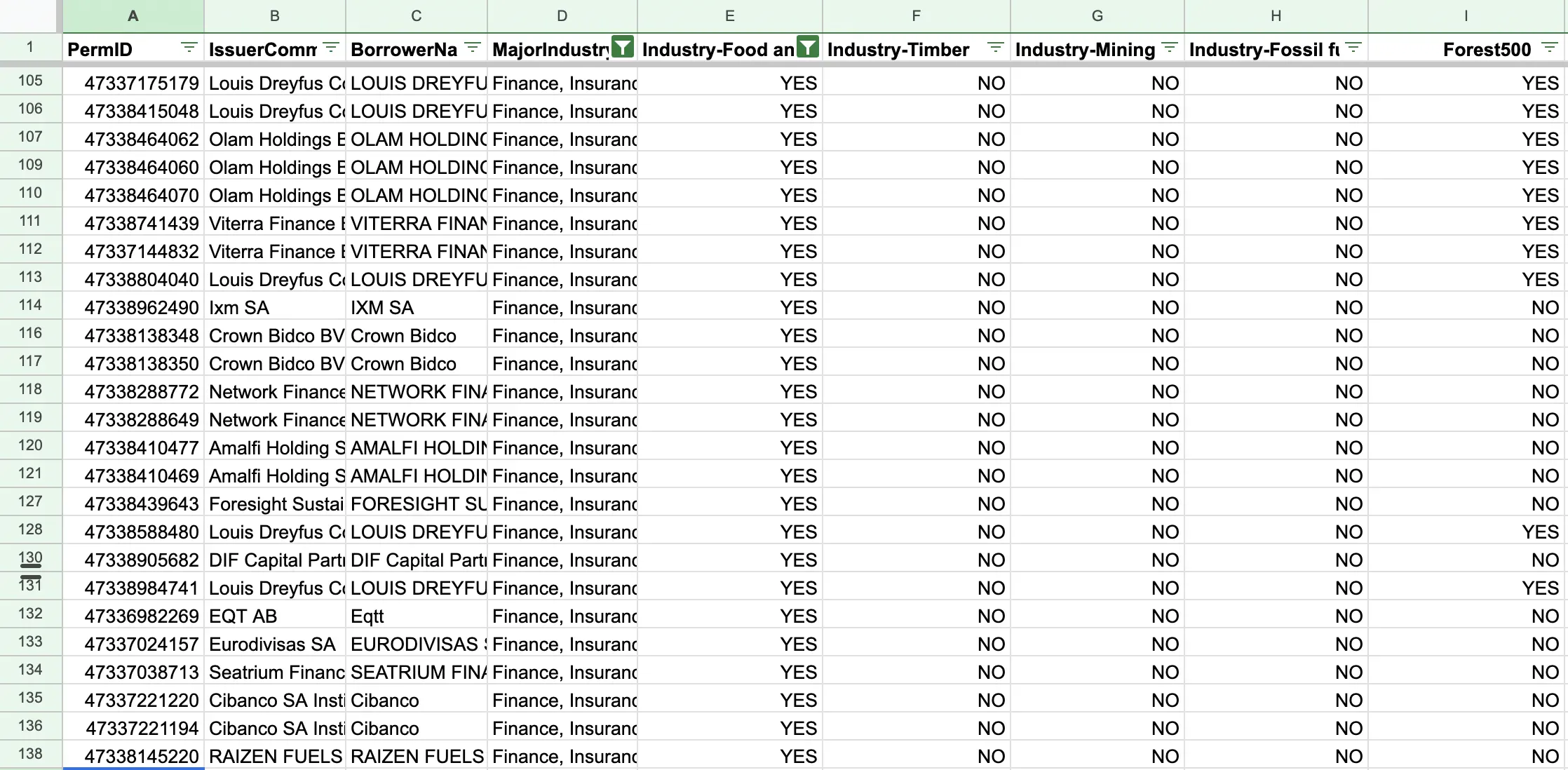
Companies in this spreadsheet fall within polluting industries, but their inclusion does not suggest that they individually contribute to climate change. Image: Courtesy of The Examination.
3. Finding Case Studies
Another key challenge was picking a central case to investigate. After researching more than a dozen companies in polluting industries that we identified in our data analysis as having benefited from SLLs, we decided to focus on the UK-based energy producer Drax Group. Drax generates electricity by burning wood pellets, and presents itself as a leader in renewable energy because it is switching away from coal power. But there’s a major catch: scientific studies show that burning wood biomass is actually even worse for the climate than coal.
Drax’s main power plant in North Yorkshire, England uses wood pellets imported from other countries, notably the United States. Drax owns pellet plants in towns across the US South, and they are disproportionately located in poor, majority Black communities. We travelled to Gloster, Mississippi, a community of fewer than 1,000 people where Drax opened a plant in 2016. Mississippi regulators have imposed record fines on Drax for air pollution violations in Gloster, and a growing number of residents say they are suffering debilitating respiratory problems as a result. We spoke to more than a dozen people in Gloster about how they were affected.
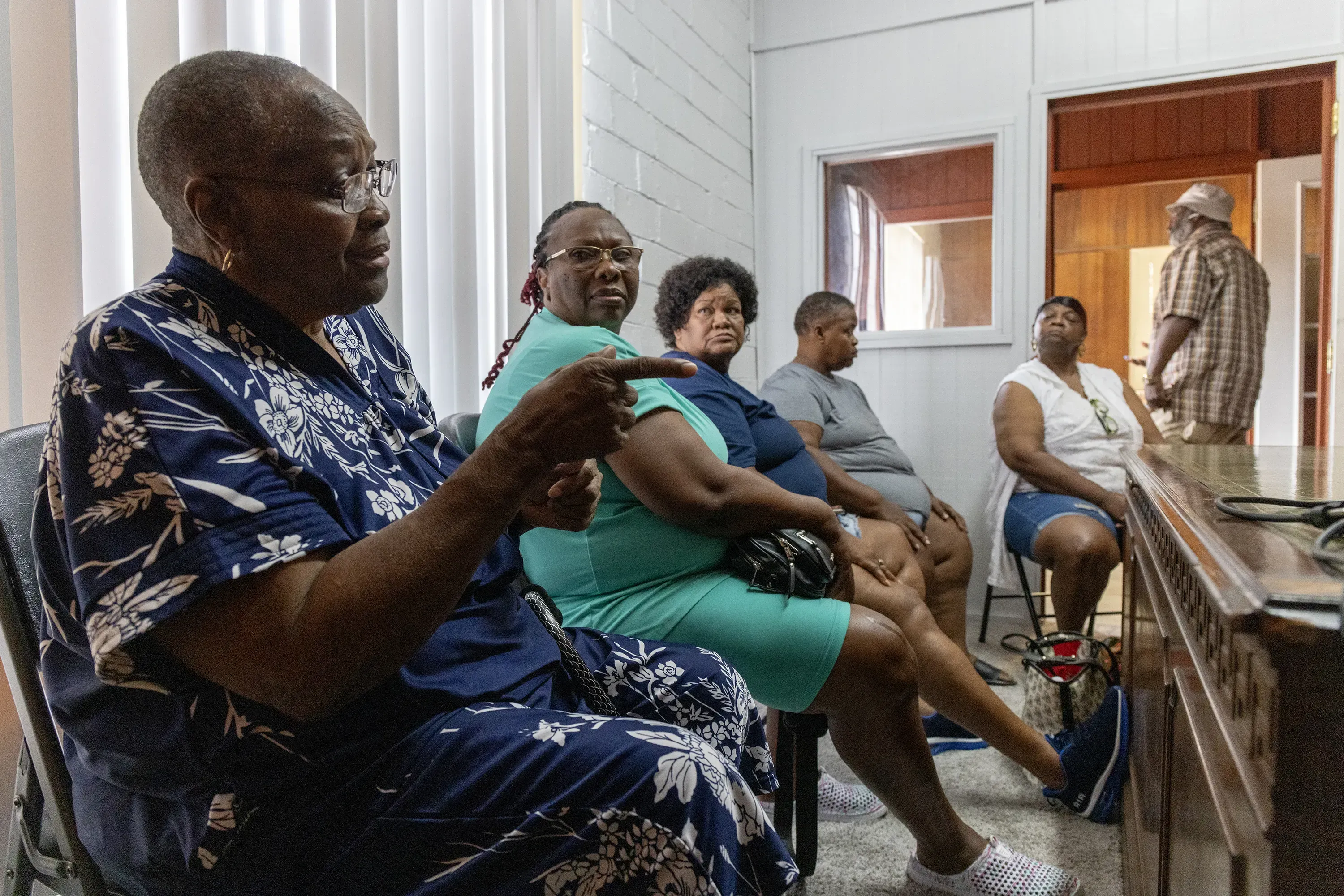
Community members in Gloster, Mississippi, describe the potential effects of Drax’s Amite wood pellet plant on their health and the local environment. Image: Courtesy of Eric Shelton, Mississippi Today
4. Presenting our Findings
We felt strongly about presenting our findings in a creative and engaging way. We were fascinated by the massive volumes of loans going to polluting industries, but let’s be honest — if our package was all about numbers and wonky financial products, it would put readers to sleep.
We decided to feature a creative visualization of our findings as the lede for our story. We hired a talented illustrator, Alejandra Saavedra, and commissioned five images based on a written script we had prepared. The scripts included our key data findings, and you can see an example of the results here: eerie, dystopian, and (in my opinion!), compelling.
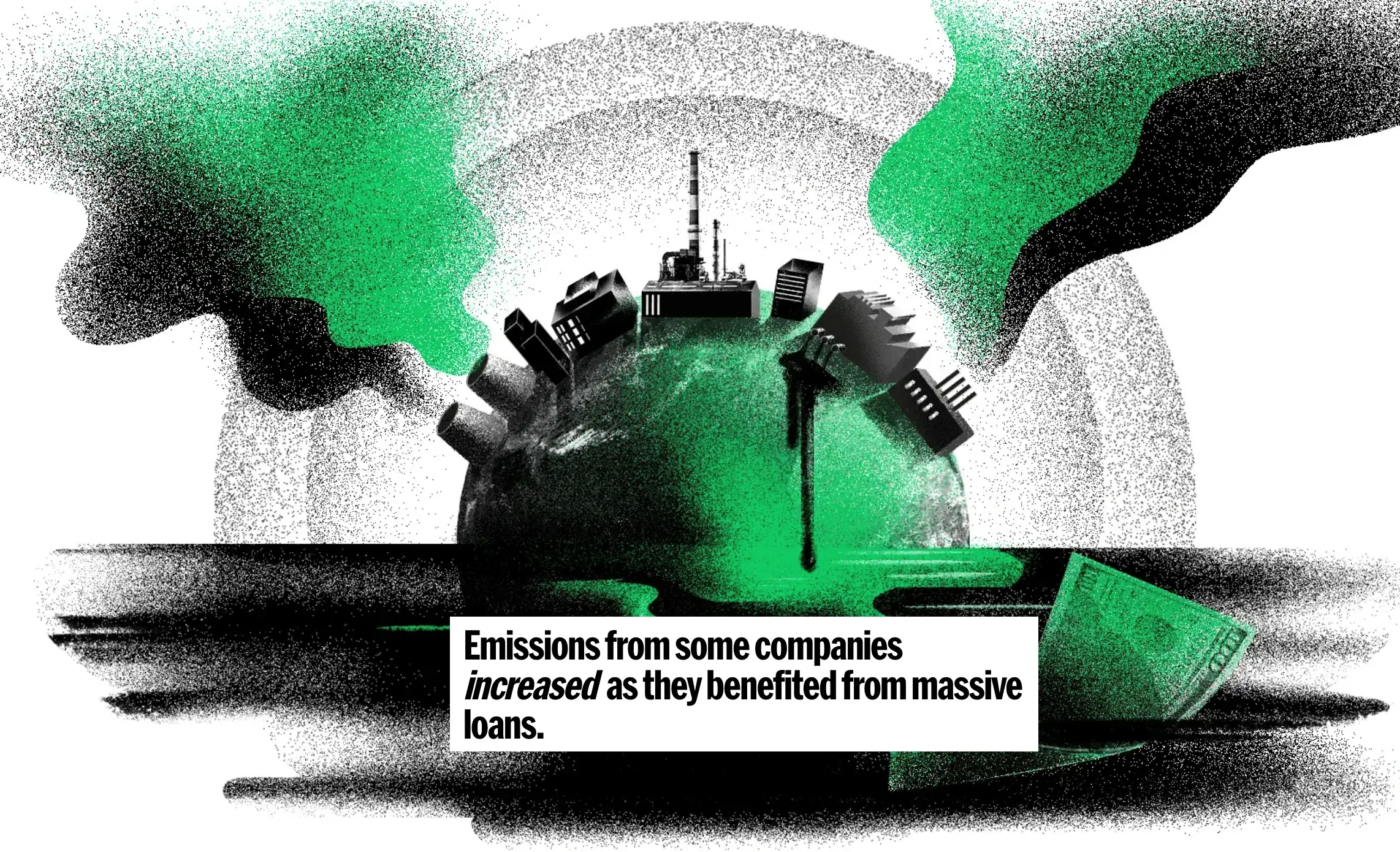
Illustration: Courtesy of Alejandra Saavedra, The Examination.
In addition to our visualization and story, we decided to pierce the secrecy surrounding sustainability-linked loans by publishing our own dataset. We couldn’t publish all of the SLLs because of the terms of LSEG subscriptions, but we did publish a dataset on the SLLs that went to polluting industries. The dataset is available on The Examination’s website as a resource for anyone else who wants to investigate.
One of the key methods we used in this project was obtaining access to private financial datasets that allowed us to do an original analysis. These datasets (LSEG, Bloomberg, etc.) are too expensive for most journalists, but we can recommend a few workarounds: asking the companies for small, specific data requests, hiring consultants to get broader data access, and working with big media partners who have their own subscriptions.
Another key method was using industry group classifications contained in the SLL data to do a big-picture analysis of which industries were benefiting from these loans. This can be replicated by deciding which big-picture industry groups are most relevant to your reporting, and if possible, using industry categories already included in your financial dataset as the building blocks for this analysis (for example, deciding you’re interested in “fossil fuels” and then reviewing more specific categories like “natural gas pipelines”).
In summary, we found that private financial datasets can offer insight to original investigative findings, but gaining access requires creativity and analyzing the data takes significant effort. We also found our financial data backbone needed to be combined with compelling storytelling to bring our findings to life, including strong visualizations and on-the-ground reporting.
This article was originally published by the Pulitzer Center and is reprinted here with permission.
 Sasha Chakvin is an investigative reporter specializing in the environment, Latin America, and public corruption. He was the lead reporter for OCCRP’s “Nicaragua’s Forgotten Deforestation Crisis” investigation and is a 2021-22 Ted Scripps Fellow in Environmental Journalism at the University of Colorado at Boulder. Chavkin was a reporter for ICIJ from 2013 to 2020, where he worked on major international investigative collaborations such as the Implant Files and Paradise Papers. His stories have led to a worldwide recall of breast implants associated with elevated cancer risks and the forgiveness of billions of dollars in federal student debt held by borrowers with severe disabilities. He holds a dual master’s degree in journalism and international affairs from Columbia University.
Sasha Chakvin is an investigative reporter specializing in the environment, Latin America, and public corruption. He was the lead reporter for OCCRP’s “Nicaragua’s Forgotten Deforestation Crisis” investigation and is a 2021-22 Ted Scripps Fellow in Environmental Journalism at the University of Colorado at Boulder. Chavkin was a reporter for ICIJ from 2013 to 2020, where he worked on major international investigative collaborations such as the Implant Files and Paradise Papers. His stories have led to a worldwide recall of breast implants associated with elevated cancer risks and the forgiveness of billions of dollars in federal student debt held by borrowers with severe disabilities. He holds a dual master’s degree in journalism and international affairs from Columbia University.


